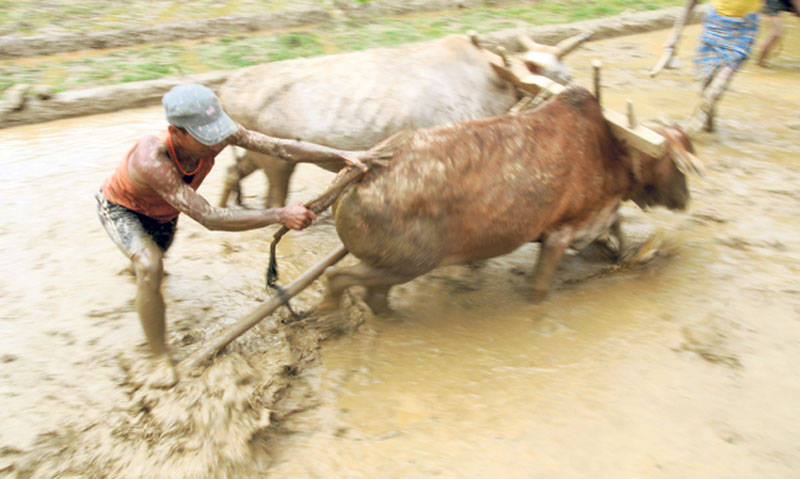
OR
Indigenous farming


Bhairab Raj Kaini
Bhairab Raj Kaini, columnist for Republica for the last ten years, is an agriculture expert with experience of forty years in the field.bhairabr@gmail.com
More from Author
Nepal’s indigenous agricultural practices are threatened by vested interests and outside pressures
By virtues of its diverse ecology and ethnic composition, Nepal possesses rich indigenous knowledge and practices on agriculture. Though geographically small, Nepal has different types of climate conditions. Farmers in Nepal also come from wide range of ethnic groups and castes. They are hard-working and have developed traditional practices and indigenous technologies through trial-and-error.
In the past, Nepal used to follow Vedic practices of food production, for those practices were in harmony with the ecosystem. Despite repeated political ups and downs, foreign influence was kept at a minimum until 1950. Even during the Muslim and British invasions of the Indian subcontinent, Nepal managed to remain free of foreign rule. Naturally, any “development” that occurred before 1950 was indigenous. Agriculture sector was no exception to this.
The indigenous knowledge and practice system (IKPS) encompasses dynamic and culture- specific knowledge, practices and beliefs. The system has evolved through adoption based on location-specific learning-by-doing and inter-generational knowledge transmission.
The term “indigenous knowledge” (IK) is used synonymously with “traditional” and “local knowledge.” IKPS is based on proper use of local resources for sustainable food production.
Terracing, slicing terrace risers, rain water harvesting, ‘in-situ’ manuring, and inclusion of legumes in crop rotations and intercropping are all age-old agronomic practices that are still in use in hilly areas.
Indigenous agro practices depend on local conditions and resources. These farming practices also use agro-ecological processes of predation, competition and parasitism to control pests. Hence, these are well adapted to their environment, rely on local resources, and realize their full production potential. The development and dissemination of local technology and optimal use of natural resources are the basis of indigenous agriculture.
Most of these practices are now threatened by vested interests and external interventions.
Low dependence on external inputs was a basic characteristic of traditional agro practices. Farmers generally did not use external inputs and even if they did, they did so in supplemental doses. For example, inter-cropping and mixed-cropping legumes with maize are common in traditional crop production that relies on biological fertility, thereby reducing the need for external inputs. It helps in pest management as well. Such practices are safe for farming community as well as the environment, and produce consistent yields.
Recycling farm-produced resources is another feature of indigenous agriculture. Integration of crops, livestock, forests, and fodder is the key to make production sustainable and to maintain soil fertility.
Such integration contributes to the synthesis of Farm Yard Manure (FYM), which is a major plant nutrient. In such practices, crop residues, forests and pastures provide feeding and bedding material to animals and in return, the cultivated land receives nutrients and organic manure from the livestock. External technological and market interventions have disrupted this cycle.
Agriculture is now forced to follow market economy. Technology use is limited to rich and knowledgeable people. As agriculture is commercialized, indigenous practices are undermined, adversely affecting our environment. Most agriculture policies and strategies these days are also ‘commercial’. Coupled with weak institutional arrangements and profit-oriented technological interventions, they threaten self-reliant agricultural practices across the world.
Understanding indigenous farming systems through indigenous knowledge and practices helps us realize the importance of a self-reliant, economically viable, ecologically sound, and socially sustainable agriculture system. Many farmers in remote areas are still managing their crops and lands in this way.
They mostly grow local varieties of crops and domesticate local breeds of animals. They diversify farming to reduce the risk of complete crop failure and use labor, local equipment, and other locally available inputs to reduce dependence on outside products.
Diversified systems such as multiple cropping and/or inter-cropping were common in traditional agriculture. Farmers lived close to natural resources and, hence, they quickly adapted to the changes around them. These farmers also maintained their traditional crop lands, evolved and adapted to the local farms for generations.
In traditional farming, most crop seeds come from varieties developed over many generations of selection without formal plant breeding. The seeds nurtured by these farmers allow for continuous crop adaptation and selection. They produce and store seeds using local techniques. In fact, the genetic diversity in traditional farming is the main source of raw materials for modern cultivars of crops and commercial animal breeds.
Indigenous and local fodder and pasture management practices have evolved from our ancient cultural norms, values, context, community-based institutions and sound understanding of local ecosystems. Government agencies should, therefore, recognize and promote them as climate-adaptive and resilient practices.
In this connection, good indigenous practices based on resource-conserving technologies such as integrated pest management and soil and water conservation need to be shared and transferred to modern farmers.
On-farm conservation by which farmers maintain the traditional crop varieties they develop should be transmitted to the next generation. For this, we need a policy document based on a widely shared consensus for attracting young generation in commercial agriculture that is firmly based on traditional practices.
bhairabr@gmail.com
You May Like This

Alfesco Open Art Exhibition begins at Nepal Art Council
KATHMANDU, Feb 14: Alfresco Media and Event organized ‘Alfresco Open Art Exhibition and Competition 2017’ for pre-primary level to college level... Read More...

Men less likely to test for HIV than women, at higher risk of dying of AIDS
Around the world, fewer than half of HIV-positive men are getting treatment, compared to 60 % of women, according to... Read More...

Five works of art you should know
You don’t have to be an art historian to know what the Mona Lisa looks like. In fact, you don’t... Read More...





_20220508065243.jpg)


Just In
- Over 400,000 tourists visited Mustang by road last year
- 19 hydropower projects to be showcased at investment summit
- Global oil and gold prices surge as Israel retaliates against Iran
- Sajha Yatayat cancels CEO appointment process for lack of candidates
- Govt padlocks Nepal Scouts’ property illegally occupied by NC lawmaker Deepak Khadka
- FWEAN meets with President Paudel to solicit support for women entrepreneurship
- Koshi provincial assembly passes resolution motion calling for special session by majority votes
- Court extends detention of Dipesh Pun after his failure to submit bail amount










Leave A Comment